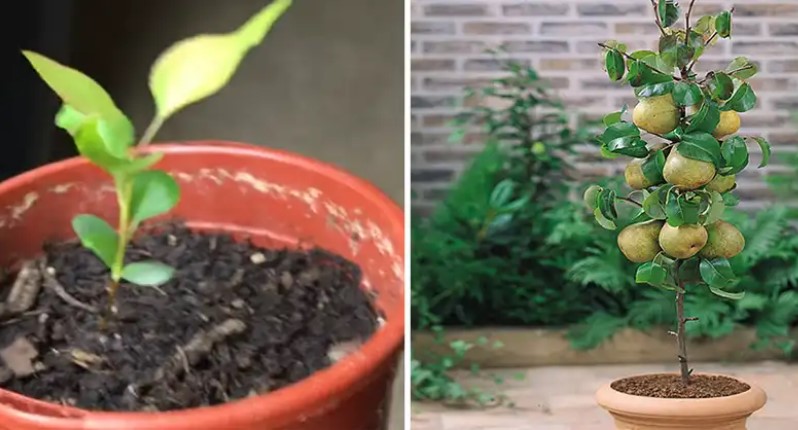Growing a pear tree from seed can be a rewarding and educational experience. In this guide, we will walk you through the step-by-step process of growing a pear tree in pots. This method allows you to nurture your tree from the very beginning and witness its growth up close.

Materials You’ll Need:
- Ripe pears
- Paring knife
- Bowl of tap water
- Bleach
- Resealable plastic bags or sandwich bags
- Damp peat moss or potting soil
- Small containers or plastic cups
- Potting mix
- Well-lit location
Step 1: Harvesting Seeds
Start by collecting pear seeds from ripe pears. Cut the fruit into quarters lengthwise, from stem to base, and carefully remove the seeds using a paring knife. It’s a good idea to gather as many seeds as possible, as not all of them will necessarily germinate. More seeds mean a better chance of success.
Step 2: Soaking the Seeds
Soak the collected seeds in a bowl of tap water overnight. Remove any seeds that float to the surface, as these are unlikely to germinate. The next morning, soak the seeds in a solution of ten parts water to one part bleach for ten minutes. Then, drain the seeds and let them dry on a paper towel.
Step 3: Bagging the Seeds
Fill a resealable plastic bag or sandwich bag with moist peat moss or potting soil (make sure it’s damp but not soaked). Plant two or three seeds about two to three inches deep into the medium. You can place up to four seeds in each bag. Seal the bag and put it in the crisper drawer of your refrigerator. Allow the seeds to germinate for three months, checking the moisture levels every two weeks to ensure they don’t dry out.
Step 4: Seed Preparation
Once three months have passed and the room temperature is above 40 degrees Fahrenheit, you can remove the seeds from the fridge. Soak the seeds in a bowl of warm water for two days to soften their hard shells. Discard any seeds that float to the top.
Step 5: Planting in Containers
Fill small containers or plastic cups with potting mix. Plant each seed half an inch deep near the sides of the container, ensuring even spacing between them.
Step 6: Watering and Care
Keep the soil damp but avoid overwatering, as it can harm the seedlings or lead to root rot. Place the containers in a well-lit location, such as a windowsill with full sun, and leave them there for two to three weeks.
Step 7: Monitoring Growth
Over the next two to three weeks, monitor your seeds as they sprout small cotyledons. Subsequently, they will develop true leaves, which resemble the leaves of a pear tree. When your sprouts have four true leaves, you can consider replanting them in a larger container or garden.
Step 8: Transplanting Pear Trees
Choose a suitable location in your garden for transplanting your pear tree. Dig a hole slightly larger than the root ball of your young tree and ensure well-draining soil by testing with water. Gently remove your baby pear tree from its growing container, replant it in the soil, and water it immediately. Continue to nurture your plant as it establishes its root system over the next few years.
Four Tips for Successful Pear Tree Growth:
- Support the Tree: Once your pear tree develops a trunk, place a wooden stake beside it and graft the tree to the stake using gardening wire. This will help the tree grow upright and develop a strong trunk.
- Regular Watering: During the first year, water your pear tree once a week to keep the soil consistently moist. In dry seasons, you may need to increase the frequency. Always check the soil between waterings to prevent it from drying out.
- Annual Fertilization: Feed your tree annually with ammonium nitrate fertilizer. Adjust the amount as the tree grows larger.
- Pruning: Keep an eye on the branches for signs of drying or dead leaves. Prune them with gardening shears in the early spring to redirect nutrients to healthy branches.
How Long Does It Take to Grow a Pear Tree from Seed?
Growing a pear tree from seed is a patient endeavor. It may take three to ten years for the pear seeds to develop into mature pear trees that bear fruit. The process involves various stages, including cold stratification, germination, and planting in the soil, each taking several months.
When Should You Plant Pear Seeds?
Collect pear seeds in winter, typically from January to early February. This timeframe allows your pear seeds to undergo the required chilling period in the fridge before they are ready for planting in the ground. Aim to plant them in May or June, when there is ample sunlight, and the last frost has passed reliably.









